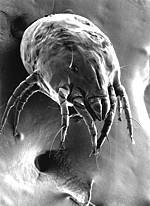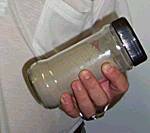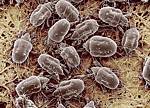
House Dust Mites
This information sheet provides people with asthma and carers of children with asthma information on dust mites by explaining what they are, how to decrease their numbers and what precautions to take.
Most people with asthma find that a number of provoking factors (trigger factors) cause them to have attacks or make their asthma worse. A common trigger factor for asthma is the house dust mite.

House dust mites are microscopic creatures which thrive in warm moist places, feeding on dead skin scales. The most common places to find dust mites are in beds and carpets. It is the mite’s faecal matter that readily becomes airborne, and when inhaled, can provoke a strong allergic response. Dust mites can produce up to 200 times their own weight of faeces in their lifetime. They are extremely sensitive to dry conditions and changes in temperature. The house dust mite population is high around the coastal areas of Australia and scarce in drier inland places.
How is asthma that is triggered by house dust mites treated?
Preventative treatment for asthma is preferable. It is important to get rid of trigger factors and reduce exposure to house dust mites rather than relying solely on medication for control. If asthma has been shown to be triggered by house dust mites, it is best to concentrate on reducing the dust mite from carpets and bedrooms. Most allergens remain trapped in beds and carpets, and only a small proportion become airborne.

- Keep bedrooms well ventilated and well lit with natural light.
- Use mattress, doona and pillow protectors. Clean the covers regularly.
- Dust Mite excrement from queen mattress after 5 yearsHot wash (greater than 55ï‚°C) bedding sheets, pillows cases and quilts, in soapy water at least once every two weeks. If possible, dry the bedding in sunlight, as the mite is sensitive to ultra violet light. Cold water does not kill the dust mite. Eucalyptus oil added to the wash is also beneficial.
- Air blankets weekly, where possible in natural sunlight.
- Showering before going to bed is thought to be of benefit
- Vacuum the mattress and any upholstered furniture weekly.
- Vertical blinds are better than heavy drapes or curtains which harbour dust.
- Put fluffy toys in the deep freeze once a week for 24 hours. This kills dustmites but not the allergen. A further wash at any temperature will get rid of dustmite faeces.
- Damp dust weekly. This is more beneficial than feather dusting.
- Minimise the number of items stored under beds and on top of wardrobes.
- Minimise open book shelves.
- Expose floor rugs to sunlight after vacuuming.

- Fluffy toys should not be kept on the bed. Better still buy toys that are not fluffy.
- Avoid having carpets in the house. Timber and vinyl coverings are preferred along with other hard coverings, as they are easily cleaned.
- Where possible, buy wooden, vinyl or leather furniture. Upholstered furniture can harbour dust mites. If you have upholstered furniture, vacuum it weekly.
- When purchasing a new vacuum cleaner ensure that it has an adequate dust filtering system.
- The person with asthma should try to avoid doing the vacuuming. However if this is unavoidable, weekly vacuuming should be performed with the windows and doors open.
- After vacuuming, leave the house and allow the dust to settle for a half and hour or so before re-entering.
- Wet and steam cleaning removes mites from carpets more readily than vacuuming but research suggest that it only improves it by two thirds and the residual water left from the cleaning may promote fungal growth.
- Dry cleaning kills the mites but again has little effect on the level of faecal material that is the aggravating allergen.
- Using chemicals provides only moderate control of the allergens. The chemicals kill the mite but do not remove the allergen. There is some concern regarding toxicity in relation to children.
- Choose window coverings that can be easily cleaned.
- Sheepskin products are best avoided, but if their use is essential, wash in hot water, (greater than 55ï‚°C) or place in the deep freeze for 24 hours each month.
It is important to remember that improvement of asthma symptoms occurs as the result of massive reduction in dust mite allergens.
Skin testing for the dust mite and other allergens is most useful for patients with chronic/severe asthma. Early exposure to allergens in infancy is of possible significance in the development of asthma. It is therefore suggested that good house dust mite control be practised whilst children are young.
- Information sheets are also available on Carpets/Vacuum Cleaners, and Asthma and allergy.
- For further information call Asthma Victoria on 1800 645 130 or visit Asthma Victoria’s website: www.asthma.org.au
This resource satisfies the guidelines and standards approved by the National Asthma Campaign and Asthma Australia.
The materials contained in this publication are distributed for information purposes only. Suitable medical and professional advice should be obtained before acting on any information contained herein.